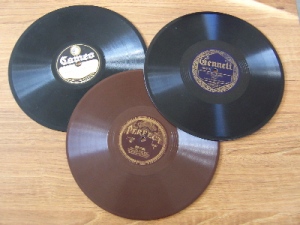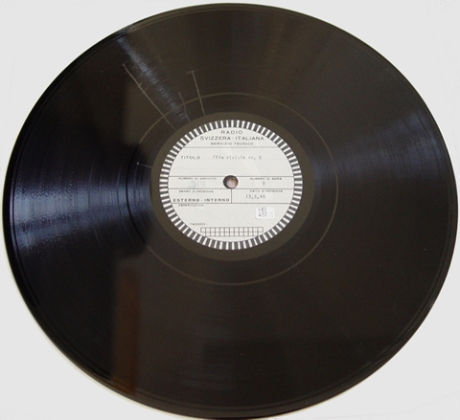Shellac/78s
Coarse groove gramophone discs — “shellacs” or “78s” — were the primary mass-produced audio format for the first half of the 20th century. The earliest shellac records were a combination of 25% shellac, a cotton compound,  powdered slate and wax lubricant, though by 1898, they were wholly shellac. Recordings made prior to 1925 were created acoustically, by the conversion of the physical energy of sound to mechanical vibration to “cut” the disc. Electrical recordings — those captured by microphones and amplified with vacuum tubes — debuted in 1925 and have been in use to this day, regardless of format. 78s were generally 10″ in diameter (though radio transcription and movie soundtrack discs were often 16″), and spun on a turntable at approximately 78 revolutions per minute, though this rate was not standardized until the late 1920s, and these records’ RPMs can range anywhere from 60 to 130 RPM.
powdered slate and wax lubricant, though by 1898, they were wholly shellac. Recordings made prior to 1925 were created acoustically, by the conversion of the physical energy of sound to mechanical vibration to “cut” the disc. Electrical recordings — those captured by microphones and amplified with vacuum tubes — debuted in 1925 and have been in use to this day, regardless of format. 78s were generally 10″ in diameter (though radio transcription and movie soundtrack discs were often 16″), and spun on a turntable at approximately 78 revolutions per minute, though this rate was not standardized until the late 1920s, and these records’ RPMs can range anywhere from 60 to 130 RPM.
Listen to an old 78: “Take Care of the Farmer,” Whitey Johns
Acetates
A bit of a misnomer, most acetates are actually aluminum (or glass or cardboard) discs coated with nitro-cellulose lacquer and playable only on one side. Many of these are one-of-a-kind recordings, were not created to be played numerous times, and are at serious risk of deterioration. They can be recognized by their handwritten labels and often additional holes near the center of the disc, which were used for stability when cutting (though these may be hidden under the label). 
Acetate disc
Listen to an old aluminum acetate: “The High Level,” Michael Coleman (1940)
Vinyl/microgroove
Vinyl records — primarily made of polyvinyl chloride — supplanted shellac discs in the 1940s as the consumer music format of choice for most of the second-half of the 2oth century (until they were in turn surpassed by compact discs). Beginning in the 1930s, radio programs began being shipped to stations on vinyl, as they were less likely to be broken in the mail, though a wartime shortage of shellac also hastened shellac’s demise.
These are also known as “microgroove” discs, as they contain between 200-300 grooves per inch.The most recognizable versions of these records are 45s (7″ records, spun at 45 RPM) and 12″ LPs, which spin at 33-1/3 RPM. The RIAA standards are more specific:
The inch dimensions are nominal, not precise diameters. The actual dimension of a 12 inch record is 11.89 in. (302 mm), for a 10 inch it is 9.84 in. (250 mm), and for a 7 inch it is 6.89 in. (175 mm).
It is estimated that the number of vinyl recordings in sound archives worldwide may top 30 million.
Stephen Haag, LIS 439